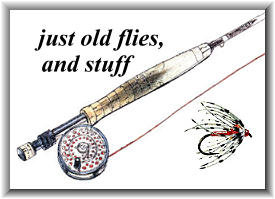Most of us can't remember a time when various forms of 'flash'
were not readily available for the fly tier. Today's tier has a huge
variety of materials from which to choose. Here is one of the
first series of flies to use 'flash.'
Quoting Streamer Fly Tying & Fishing by Joseph
D. Bates, Jr., "This series of five imitative patterns was originated
by Mr. Bob Zwirz, of Connecticut (proprietor of The Anglers Cove,
Inc., 478 Third Ave., New York City), and by Mr. Kani Evans, of
New York, over a period of several years prior to 1963 in an effort
to copy closely the five most important species of minnows common
to waters in the northern states. The use of mylar is important in the
series, to provide flash along the sides rather than along the belly of
each pattern. The series was introduced by Mr. Zwirz in an article
in the March, 1963 issue of Field and Stream and
in other publications.
The five flies are dressed, using size 000 white silk thread, on 4X long
shanked hooks in sizes from No. 8 to No. 2. All have fully built-up
heads painted with clear lacquer and tinted with colors in the dressing
instructions which follow. Rather large white or cream-colored eyes with
black pupils are painted on the heads. Bodies are of spun fur in colors
specified in the dressings, tapered full toward the head of the fly and
picked out on the sides with a dubbing needle, the picked-out hairs then
being stroked backward toward the tail.
The wings are of whole marabou feathers in colors as noted. Each feather
is wetted, preferable by running it through the lips before placing it on the
shank of the hook. The mylar is cut in strips slightly less than one-quarter inch wide
(depending on size of the fly); tied in horizontally on each side of the wing,
extending slightly beyond the bend of the hook and cut on the lower sides
toward the ends to taper upward gradually to a point. Wings are slightly longer
than the mylar. Throats and tails are a small bunch of fibers stripped from
saddle hackles, slightely longer than the gap of the hook. If the mylar does not
cling to the marabou wing, it can be brushed on the inside lightly with
clear head cement. For purposes of simplicity these general instructions
are given for all the flies and are not repeated in the individual dressings . . ."
The other four flies in this series are the Blueback Shiner, Golden Shiner,
Longnose Dace and Silver Shiner. The recipe which follows is also from
Streamer Fly Tying & Fishing.
Miracle Marabou Streamer
Blacknosed Dace
[Hook: 4X long shanked hook in sizes from No. 8 to No. 2]
Head: Top half, brown; lower half, white
[Thread: 000 white silk thread.]
Tail: Cream or very light ginger
Body: Antique white [dubbed fur]
Throat: Same as tail
Wing: Two whole antique white marabou feathers, over which are two
whole light drab (olive toward brown tone) marabou feathers
Mylar: Silver, with upper third painted black, the paint extending from the
tip to the painted eye. (Use black "Magic Marker" pencil, or lay a narrow (wetted)
strip of black saddle hackle just over the mylar.)
"The blacknose dace is a small member of the Dace family vitally important as
a bait for trout. It is widely distributed from the St. Lawrence southward through
Georgia and westward to the Mississippi in the more northerly latitudes. It is
exceedingly common in small, clear brooks and prefers moving water but avoids
the very fast riffles which harbor its cousin, the longnose dace."
~ DLB
Credits: Photo from Forgotten Flies published by the Complete Sportsman.
|



